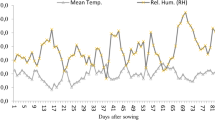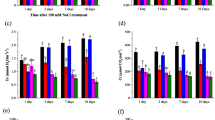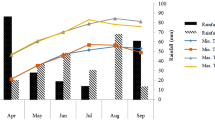Abstract
Irrigation water is the basic resource to exploit the potential of cotton crop under an arid or a semi-arid environment. Under limited water conditions, various compatible solutes like glycinebetaine are being used to ameliorate the drought stress. Exogenous application of glycinebetaine (GB): GB1 (100 mg L−1), GB0 (no application) was done in adequate water (DS0) and in drought stress condition (DS1) at arid environment during the growing seasons of years 2009 and 2010. Results demonstrated that application of GB improved the physiological processes of crop leading to better crop performance. Exogenous application of GB increased the drought tolerance with remarkable improvement in photosynthetic process and exhibited higher growth and yield. It was further noted that this technique was economically sustained; predicted higher radiation and water-use-efficiency; and can be applied in limited water condition to avoid yield losses.




Similar content being viewed by others
References
Anonymous (2013). Economic Survey of Pakistan. Government of Pakistan, Finance Division, Economic Advisor’s Wing, Islamabad, pp 15.
Azam MM, Waris A, Nahar NM (2005) Prospects and potential of fatty acid methyl esters of some non-traditional seed oils for use as biodiesel in India. Biomass Bioenergy 29:293–302
Cui XH, Fu-Shun H, Chen H, Chen J, Wang XC (2008) Expression of the Vicia faba VFPIP gene in Arabidopsis thaliana plant improves their drought resistance. J Plant Res 121:207–214
Deng XP, Shan L, Zhang H, Turner NC (2004). Improving agriculture water-use- efficiency in arid and semi arid areas of China. In: Proceedings of the 4th International Crop Science Congress Brisbane: 1–14.
Doorenboss J, Pruitt WO (1977). Guidelines for predicting Crop Water Requirements. Irrigation and Drainage paper 24, Food and Agriculture Organization of the United Nations, Rome.
Esha BS (2011). Mechanism of drought tolerance in cotton-Response of cotton cultivars to irrigation in the Texas high plains. MSc. Agricultural Thesis in Texas Technical University, Texas.
Farooq M, Basra SMA, Wahid A, Cheema ZA, Cheema MA, Khaliq A (2008) Physiological role of exogenously applied glycinebetaine to improve drought tolerance in fine grain aromatic rice (Oryza sativa L.). J Agron Crop Sci 194:325–333
Ferrari S, Junior EF, Ferrari JV, Pereira GA (2011) Cotton development and yield according to nitrogen application and cover crops. Ciênc Agrár Londrina 32:1405–1416
Gorham J, Jokinen K, Malik MNA, Khan IA (2000). Glycinebetaine treatment improves cotton yields in field trials in Pakistan. In: Proceedings of the World Cotton Research Conference II, Athens, pp 624–627
Grieve CM, Grattan SR (1983) Rapid assay for the determination of water soluble quaternary ammonium compounds. Plant Soil 70:303–307
Hossian MA, Fujita M (2010) Evidence for a role of exogenous glycinebetaine and proline in antioxidant defence and methylgloxal detoxification system in mungbean seedlings under salt stress. Physiol Mol Biol Plants 16:19–29
Hunt R 1978. Plant Growth Analysis. The Inst. of Bio. Studies in Bio. Edward Arnold (Pub.) Ltd., 96: 8-38.
Hussain M, Malik MA, Farooq M, Ashraf MY, Cheema MA (2008) Improving drought tolerance by exogenous application of glycinebetaine and salicylic acid in sunflower. J Agron Crop Sci 194:193–199
Khan MA, Shizari MU, Khan MA, Mujtaba SM, Islam E, Mumtaz S, Shereen A, Ansari RU, Ashraf MY (2009) Role of proline, K/Na ratio and chlorophyll content in salt tolerance of wheat (Triticum aestivum L.). Pak J Bot 41:633–638
Killi F, Efe L, Mustafayev S (2005) Genetic and environmental variability in yield, yield components and lint quality traits of cotton. Int J Agri Biol 7:1007–1010
Kreig DR 1998. Interaction between plant density and water supply affects cotton yield. Fluid J 1–4.
Mahavishnan K, Rekha KB (2007) Response of cotton (Gossypium hirsutum L.) to inorganic nitrogen, legume incorporation and FYM- A Review. Agri Revolut 28:289–294
Mahmood T, Ashraf M, Shahbaz M (2009) Does exogenous application of glycinebetaine as a pre-sowing seed treatment improve growth and regulate some key physiological attributes in wheat plants grown under water deficit conditions? Pak J Bot 41:1291–1302
Makela P, Munns R, Colmer TD, Cundon AG, Peltonen-Sainio P (1998) Effect of foliar applications of glycinebetaine on stomatal conductance, abscisic acid and solute concentrations of salt and drought stressed tomato. Aust J Plant Physiol 25:655–663
Maqsood M, Hussain T, Tayyab M, Ibrahim M (2006) Effect of different irrigation levels on the yield and radiation-use-efficiency of cotton (Gossypium hirsutum L.) under two sowing methods. Pak J Agri Sci 43:21–24
Martinez AT, Speranza M, Ruiz-Duenas FJ, Ferreira P, Camarero S, Ghillen F, Martinez MJ, Del Gutierrez A, Rio JC (2005) Biodegradation of lignocellulosics: microbial, chemical, and enzymatic aspects of the fungal attack of lignin. Int J Microbiol 8:195–204
Meek C, Oosterhuis D, Gorham J (2003) Does foliarapplied glycinebetaine affect endogenous betaine levels and yield in cotton? Crop Manag. doi:10.1094/CM-2003-0804-02-RS
Moghaieb REA, Saneoka H, Fujita K (2004) Effect of salinity and osmotic adjustment, glycinebetaine accumulation and the betaine aldehyde dehydrogenase gene expression in two halophytic plants, Salicornia europaea and saueda maritina. Plant Sci 166:1345–1349
Monteith JL, Elston JF (1983). Performance and productivity of foliage in field. In the growth and functioning of leaves. Dale JE, Milthorpe FL (eds) Cambridge University Press, Butterworths, Lord. pp 499–518.
MSTAT Development Team (1989). MSTAT user’s guide. A micro computer program for the design and analysis of agronomic research experiments. Michigan State University, East Lansing
Patil MP, Biradar DP, Patil VC, Janagoudar BS (2011) Response of cotton genotypes to drought mitigation practices. Am Eurasian J Agri Environ 11:360–364
Sarwar MKS, Ullah I, Rehman MU, Ashraf MY, Zafar Y (2006) Glycinebetaine accumulation and its relation to yield and yield components in cotton genotypes grown under water deficit condition. Pak J Bot 38:1449–1456
Sarwar N, Ali H, Maqsood M, Ullah E, Shahzad M, Mubeen K, Shahzad AN, Shahid MA, Ahmad S (2013) Phenological response of rice plants to different micronutrients application under water saving paddy fields on calcareous soil. Turkish J Field Crops 18:52–57
Shahbaz M, Masood Y, Perveen S, Ashraf M (2011) Is foliar applied glycinebetaine effective in mitigating the adverse effects of drought stress on wheat (Triticum aestivum L.). J Appl Biol Food Quality 84:192–199
Shallan MA, Hassan HMM, Namich AAM, Ibrahim AA (2012) Effect of sodium, nitroprusside, putrescine and glycinebetaine on alleviation of drought stress in cotton plant. Am Eurasian J Agri Environ 12:1252–1265
Sikuku PA, Netond GW, Onyango JC, Musyimi DM (2010) Effects of water deficit on physiology and morphology of three varieties of nerica rain-fed rice (Oryza sativa L.). ARPN J Agri Biol Sci 5:23–29
Steel RGD, Torrie JH, Dickey DA 1997. Principles and Practices of Statistics, A Biometric Approach. 3rd Edition. McGraw Hill, International Book Co, Inc, Singapore.
Subbarao GV, Wheeler RM, Levine LV, Stutte JW (2001) Glycinebetaine accumulation, ionic and water relations of red-beet at contrasting levels of sodium supply. J Plant Physiol 158:767–776
Szeicz G (1974) Solar radiation for plant growth. J Appl Ecol 11:617–636
Watson D (1952) Comparative physiological studies on the growth of field crops. I. variation in net assimilation rate and leaf area between species and varieties and within and between years. Ann Bot 11:41–76
Wilde C, Johnson J, Keeling W, Johnson P (2008) Effect of cotton variety selection and irrigation levels on economic returns: Texas Southern High Plains. Beltwide Cotton Conf. Nashville, Tennessee, Jan, pp 8–11
Zhang Y, Hu W, Gao Y, Yao Y, Tang M, Hu G (2008) Fertilizing irrigated cotton for high yield and high nitrogen use efficiency. Better Crops 92:6–7
Author information
Authors and Affiliations
Corresponding author
Rights and permissions
About this article
Cite this article
Ahmad, S., Raza, I., Ali, H. et al. Response of cotton crop to exogenous application of glycinebetaine under sufficient and scarce water conditions. Braz. J. Bot 37, 407–415 (2014). https://doi.org/10.1007/s40415-014-0092-z
Received:
Accepted:
Published:
Issue Date:
DOI: https://doi.org/10.1007/s40415-014-0092-z




